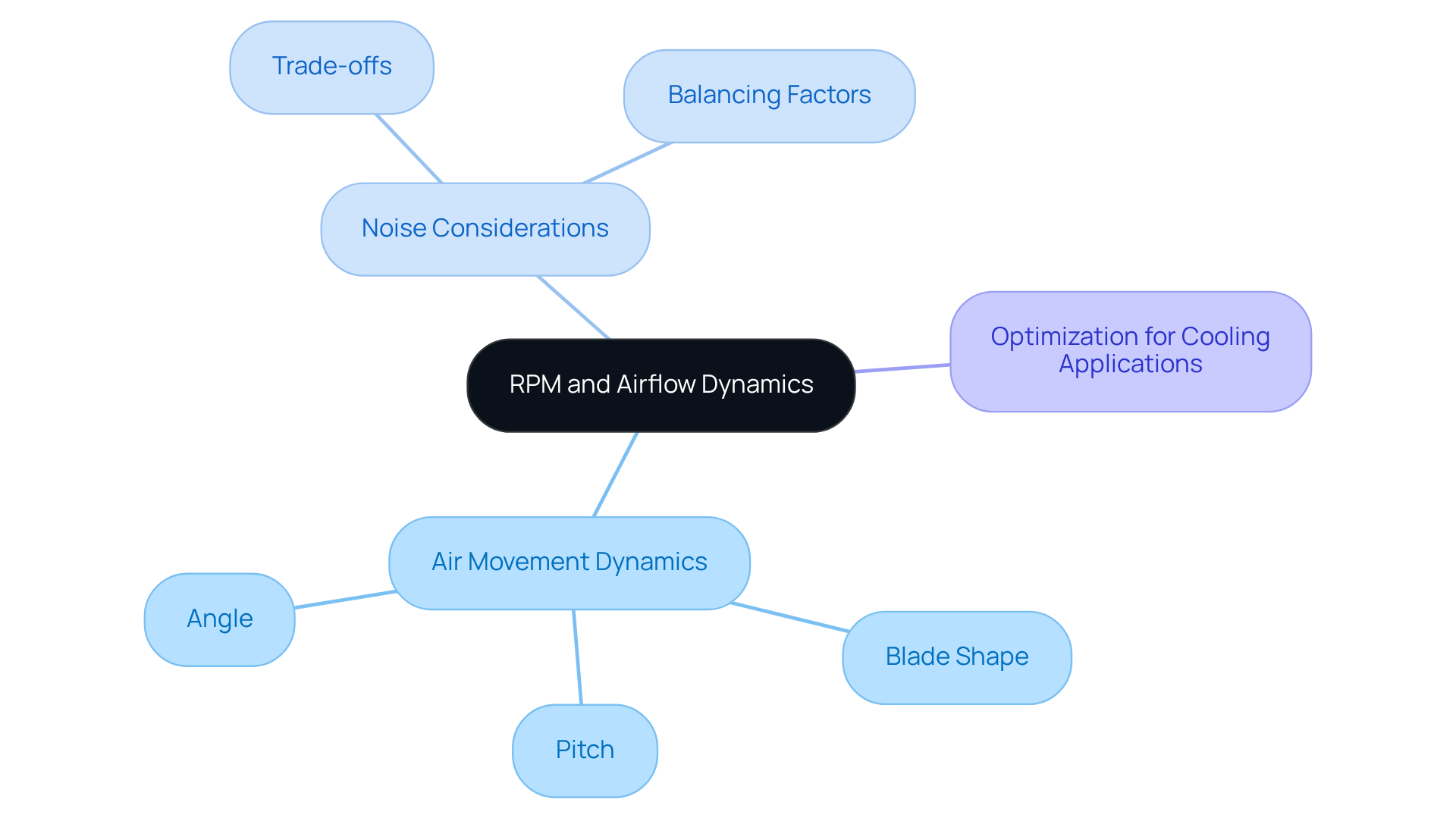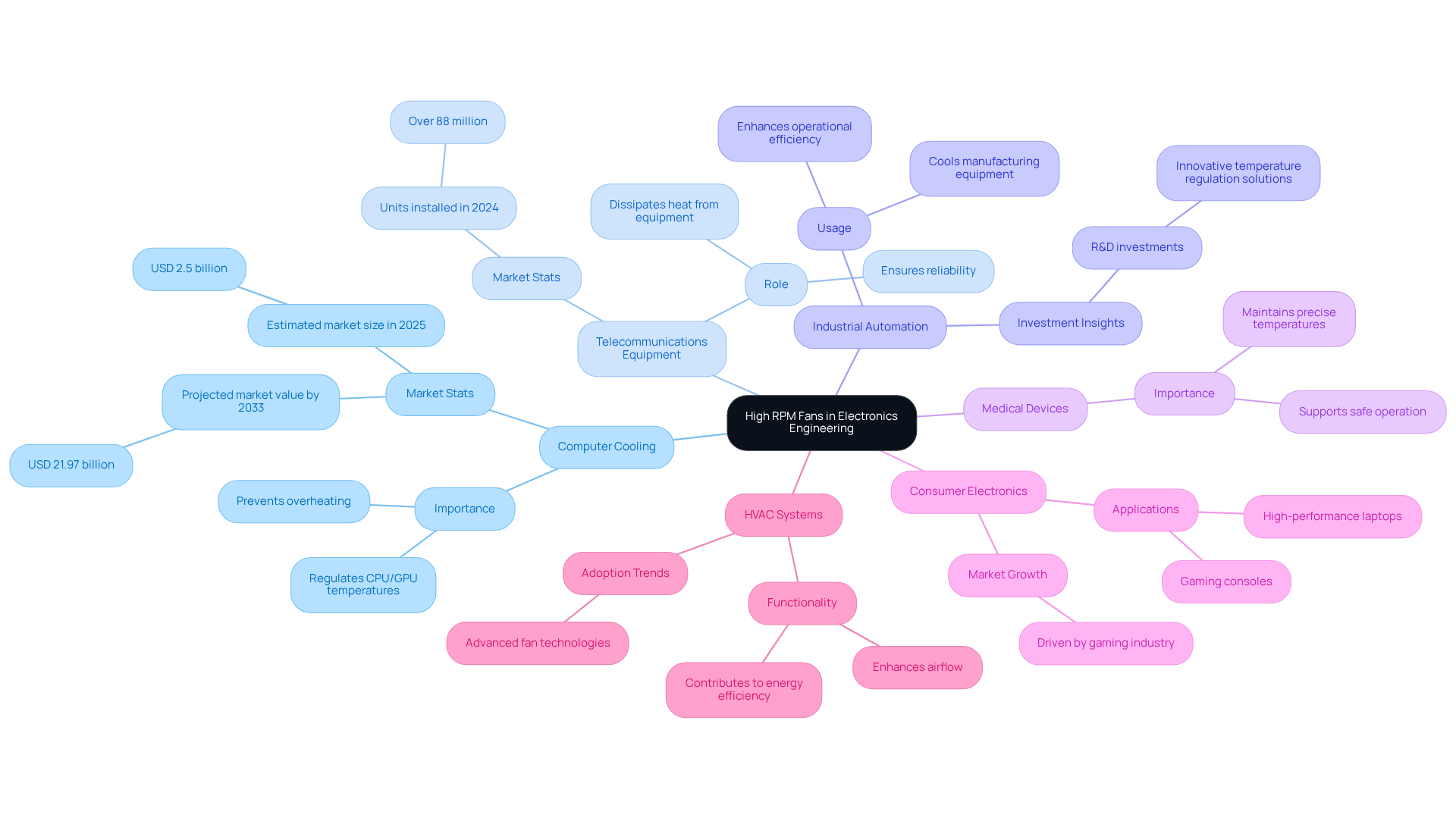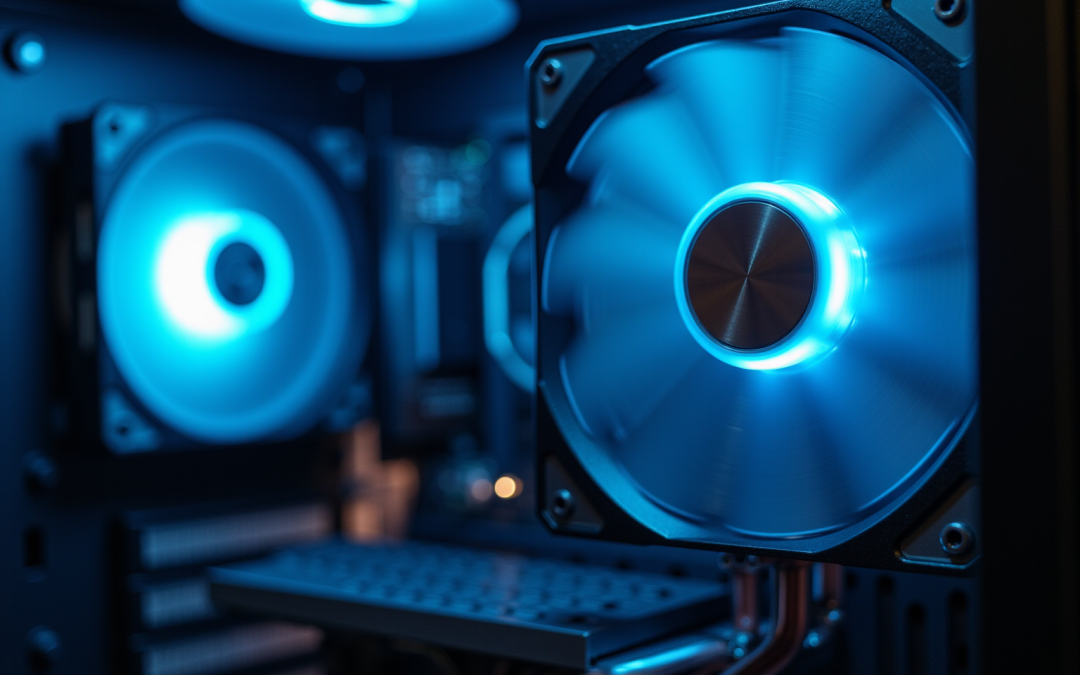Introduction
Understanding the relationship between RPM and airflow dynamics is crucial for engineers aiming to optimize cooling systems. High RPM fans significantly enhance cooling efficiency, offering compact designs and rapid responses to temperature fluctuations. These features make them invaluable across various applications. However, engineers face the challenge of balancing the advantages of increased airflow with potential noise concerns.
How can they leverage these high-performance fans to achieve maximum efficiency while ensuring a comfortable environment?
Explore Fan Basics: RPM and Airflow Dynamics
RPM, or revolutions per minute, is a critical metric that indicates how many times a fan’s blades complete a full rotation in one minute. Understanding the direct correlation between RPM and airflow, measured in Cubic Feet per Minute (CFM), is essential for optimizing cooling applications.
Higher RPM equals greater airflow: A high RPM fan operating at elevated speeds can move larger volumes of air, which is vital for effective heat dissipation. For example, increasing the RPM by 10% can lead to a corresponding 10% rise in ventilation, significantly enhancing temperature regulation.
- Air Movement Dynamics: However, the effectiveness of air movement is not solely dependent on RPM; the design of the fan blades is equally important. Factors such as blade shape, pitch, and angle dramatically influence air movement efficiency. Fans engineered for high static pressure excel at pushing air through restrictive environments, like heatsinks or filters, ensuring optimal cooling even under challenging conditions.
- Noise Considerations: While high RPM fans are superior in ventilation capacity, they often produce increased noise levels. This trade-off between ventilation and sound is crucial in environments where noise reduction is paramount, such as homes or workplaces. Engineers must carefully balance these factors to achieve effective temperature regulation without sacrificing comfort.
Grasping the interplay between RPM and airflow dynamics is vital for engineers aiming to enhance thermal management solutions. Mastery of these principles enables the design of more efficient systems that meet specific temperature control needs while considering operational constraints.

Identify Benefits of High RPM Fans in Cooling Applications
High RPM fans offer a range of advantages in cooling applications that are crucial for engineers to consider:
-
Enhanced Cooling Efficiency: High RPM blowers excel at moving larger volumes of air, which is vital for effectively dissipating heat from electronic components. For instance, increasing airflow from 1000 to 1200 CFM can significantly raise the horsepower requirement, underscoring the importance of air circulation in thermal management.
-
Compact Design: These devices can deliver the same airflow as larger, slower models, allowing for more compact designs in electronic systems. This is particularly beneficial in space-constrained environments like data centers, where high-velocity blowers can optimize performance without occupying excessive space.
-
Enhanced Performance: In scenarios where heat accumulation is critical, such as servers or high-performance computing systems, a high RPM fan plays a key role in maintaining optimal operating temperatures. They effectively prevent thermal throttling, ensuring reliable operation.
-
Versatility: High RPM fans are adaptable across a variety of applications, ranging from cooling computer components to industrial machinery. This versatility makes them a preferred choice for engineers, as their performance under diverse conditions enhances their utility across multiple sectors.
-
Cost-Effectiveness: While high RPM devices may necessitate a higher initial investment, their efficiency can lead to reduced energy consumption and lower operational costs over time. This potential for long-term savings makes them an intelligent choice for budget-conscious projects.
-
Swift Reaction to Temperature Variations: High RPM ventilators can quickly respond to temperature fluctuations, providing immediate relief when necessary. This responsiveness is essential in dynamic environments where thermal conditions can change rapidly.
By understanding these advantages, engineers can make informed decisions when selecting blowers for their cooling needs, ensuring optimal thermal management and system reliability.

Apply High RPM Fans: Use Cases in Electronics Engineering
High RPM fans are indispensable in various applications within electronics engineering, playing a crucial role in maintaining optimal performance across multiple sectors:
-
Computer cooling is crucial, and a high rpm fan is essential in PCs and servers for effectively regulating temperatures of CPUs and GPUs. This is vital for preventing overheating during demanding tasks. Notably, the global computer fan market is projected to reach USD 21.97 billion by 2033, driven by the increasing need for efficient temperature management solutions.
-
Telecommunications Equipment: In telecom systems, high rpm fans are critical for dissipating heat generated by equipment, ensuring reliable performance and longevity. The Middle East and Africa saw over 88 million units installed in 2024, highlighting the growing demand for effective temperature regulation in telecom infrastructure.
-
Industrial Automation: High rpm fans are widely utilized in manufacturing processes to cool equipment and prevent overheating, thereby enhancing operational efficiency. The substantial investments in R&D for innovative temperature regulation solutions across various sectors underscore the need for such devices.
-
Medical Devices: In medical equipment, maintaining precise temperatures is essential for safe operation. High RPM fans ensure that devices operate within safe thermal parameters, supporting the healthcare sector’s reliance on dependable temperature regulation technologies.
-
Consumer Electronics: High RPM fans are prevalent in gaming consoles and high-performance laptops, where effective temperature management is crucial for optimal performance. The gaming industry continues to grow, driving the demand for robust cooling systems to support high-performance hardware.
-
In HVAC systems, high rpm fans are used to enhance airflow and temperature regulation, contributing to energy efficiency. The HVAC sector is increasingly adopting advanced fan technologies to meet rising energy efficiency demands.
By understanding these diverse use cases, engineers can appreciate the versatility and significance of high RPM fans in their designs, ensuring optimal performance across various applications.

Conclusion
High RPM fans stand as indispensable tools for engineers dedicated to optimizing cooling systems. Their capacity to boost airflow and efficiency positions them as crucial components across various applications, from computer cooling to industrial automation. Grasping the intricate relationship between RPM and airflow dynamics not only facilitates effective thermal management but also empowers engineers to craft systems tailored to specific operational needs, all while addressing potential challenges such as noise levels.
This article has illuminated key insights, highlighting the advantages of high RPM fans, including their compact design and rapid response to temperature fluctuations. These fans excel in delivering exceptional cooling efficiency, making them ideal for a diverse array of applications, including telecommunications, medical devices, and consumer electronics. The versatility and cost-effectiveness of high RPM fans further emphasize their significance in engineering projects, enabling innovative solutions in space-constrained environments.
Mastering high RPM fan technology is essential for engineers striving for optimal thermal management. By harnessing the benefits of these fans, professionals can guarantee reliable performance across various sectors while upholding energy efficiency. Embracing these insights not only enhances engineering practices but also fosters the development of more effective cooling systems in an ever-evolving technological landscape.
Frequently Asked Questions
What does RPM stand for and why is it important for fans?
RPM stands for revolutions per minute, a critical metric that indicates how many times a fan’s blades complete a full rotation in one minute. It is important because it directly correlates with airflow, measured in Cubic Feet per Minute (CFM), which is essential for optimizing cooling applications.
How does RPM affect airflow in fans?
Higher RPM leads to greater airflow. For instance, increasing the RPM by 10% can result in a corresponding 10% increase in ventilation, which significantly enhances temperature regulation.
What factors besides RPM influence air movement efficiency in fans?
The design of the fan blades, including blade shape, pitch, and angle, significantly influences air movement efficiency. Fans designed for high static pressure are particularly effective at pushing air through restrictive environments, such as heatsinks or filters.
What are the noise considerations when using high RPM fans?
High RPM fans can produce increased noise levels, which is a trade-off between ventilation capacity and sound. This is particularly important in environments where noise reduction is essential, such as homes or workplaces.
Why is understanding RPM and airflow dynamics important for engineers?
Understanding the interplay between RPM and airflow dynamics is vital for engineers to enhance thermal management solutions. Mastery of these principles allows for the design of more efficient systems that meet specific temperature control needs while considering operational constraints.

